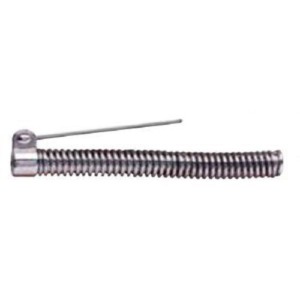Description
The L-pin Module allows for more flexible installation options and movement in the mouth. It can be used with a gingival or occlusal headgear tube. The left and right sides are universal. It is also used with the Forsus Wire Mount, permitting installation without a molar tube.
L-pin Spring Module The L-pin module allows for more flexible installation options and movement in the mouth. It can be used with a gingival or occlusal headgear tube. The left and right sides are universal
ADVANATGES:
Easy Installation:
- The Forsus appliance eliminates time-consuming laboratory setup. It is designed to be an “out of the box” appliance for easy chairside installation in one appointment. It does not require removal of the bracket or archwire for placement
Patient – Compliance:
- Patient compliance is minimized with Forsus correctors. The fixed appliance does not require the patient to remove, install or adjust the device during treatment in order for it to work properly, and therefore the Forsus device is working consistently.
Consistent Forces
- Forsus™ Class II Correctors maintain a consistent level of force throughout treatment (Table 1). Correct activation of the module exerts approximately 200 grams of force. Forsus Correctors consistently apply light force as compared to intermittently applied forces, such as that offered by facebows
Patient-Friendly:
- The compact size of the Forsus corrector helps the patient feel less discomfort. Due to the spring and telescoping cylinder design, it does not bow outward when compressed. This linear motion of the spring minimizes discomfort and assists with durability. Because the Forsus corrector does not require patient compliance, the patient and/or the parent(s) do not have to worry about the amount of time the device is actually worn
Hygiene:
- The open coil spring assembly design aids in hygiene and allows food to be brushed out of the device easily, minimizing food traps
Predictable:
- The long-lasting and consistent forces along with the compliance-free design of the Forsus device allow for more accurate predictions in treatment time and outcome
Versatile:
- The Forsus Fatigue Resistant Device can be used in a variety of Class II cases, including, but not limited to, deep bite, open bite, molar distalization, extraction, mixed dentition, and midline correction. The Forsus device allows for different size requirements for a patient’s right and left sides. If desired, it can also be used unilaterally.
FAQs
How Does the Forsus™ Fatigue Resistant Device Work?
- The Forsus device is attached to the maxillary molar headgear tube and mandibular archwire, creating a mesial force on the mandibular arch and a distal force on the maxillary arch. The intrusive force on maxillary molars can decrease posterior vertical dimension. The intrusive force can intrude mandibular incisors
Why Choose the Forsus™ Fatigue Resistant Device?
- Class II Correction is a common orthodontic case requirement. The options for Class II treatment have traditionally presented a difficult decision. Choices were limited to fixed intraoral devices with known breakage concerns, or other appliances – including headgear – that require patient compliance. The Forsus™ Fatigue Resistant Device, now with more than ten years of clinical use, overcomes these concerns and limitations.
